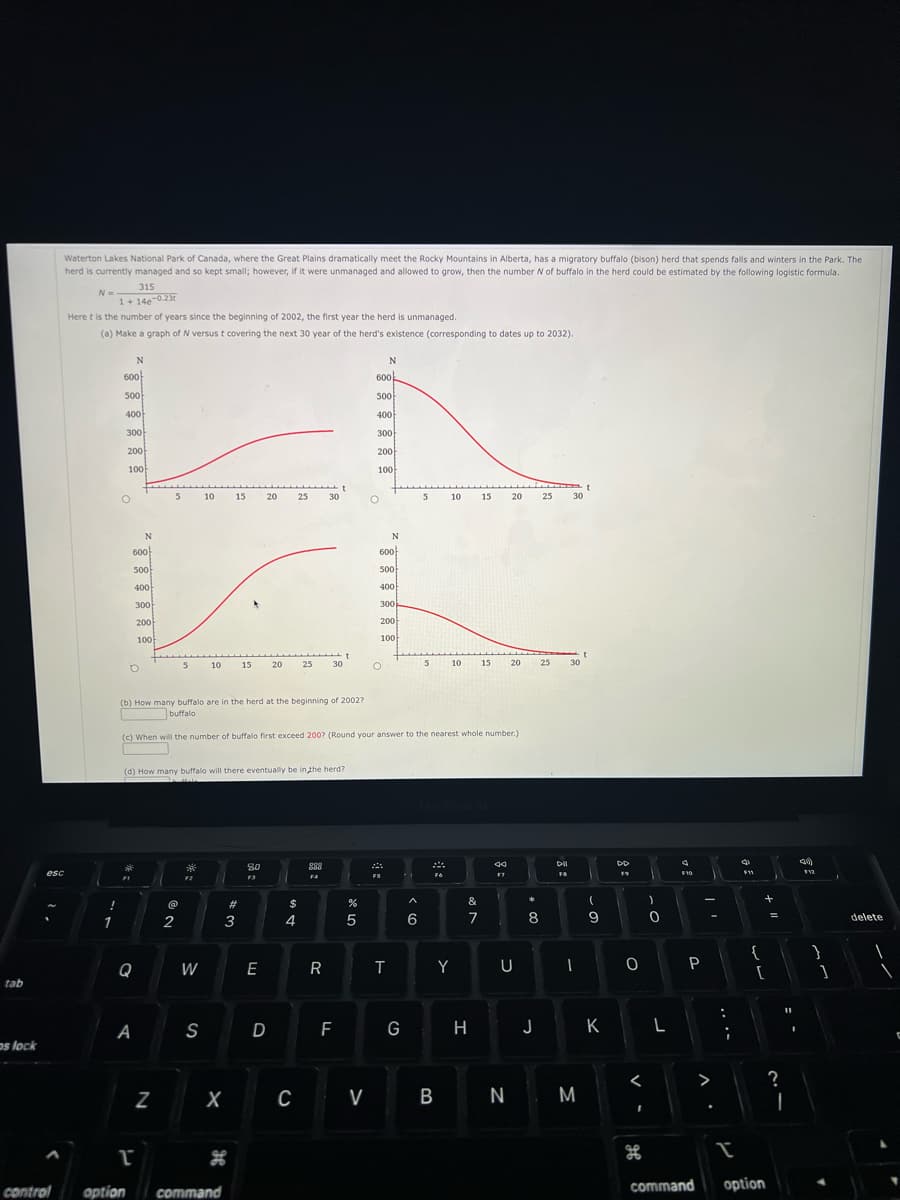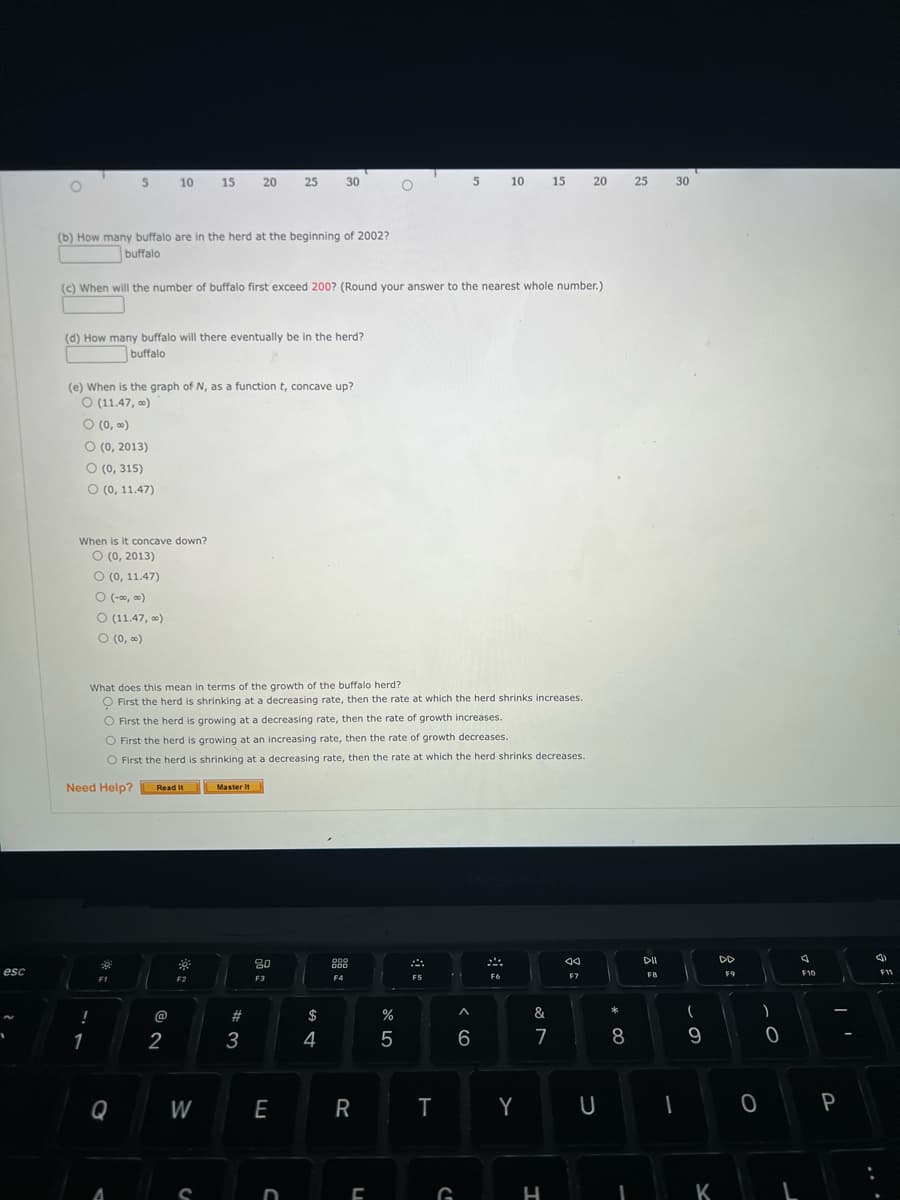Waterton Lakes National Park of Canada, where the Great Plains dramatically meet the Rocky Mountains in Alberta, has a migratory buffalo (bison) herd that spends falls and winters in the Park. Th herd is currently managed and so kept small; however, if it were unmanaged and allowed to grow, then the number N of buffalo in the herd could be estimated by the following logistic formula. 315 1+14-0.23 N= Here t is the number of years since the beginning of 2002, the first year the herd is unmanaged. (a) Make a graph of N versus t covering the next 30 year of the herd's existence (corresponding to dates up to 2032). N 600 500 400 300 200 100 N 600 500 400 300 200 100 D 5 5 10 10 15 15 20 20 25 30 1 25 30 (d) How many buffalo will there eventually be in the herd? 600 500 400 300 200 100 O N N 600 500 400 300 200 100 O 5 10 5 10 15 15 20 20 (b) How many buffalo are in the herd at the beginning of 2002? buffalo (c) When will the number of buffalo first exceed 2007 (Round your answer to the nearest whole number.) 25 25 30 30 t
Waterton Lakes National Park of Canada, where the Great Plains dramatically meet the Rocky Mountains in Alberta, has a migratory buffalo (bison) herd that spends falls and winters in the Park. Th herd is currently managed and so kept small; however, if it were unmanaged and allowed to grow, then the number N of buffalo in the herd could be estimated by the following logistic formula. 315 1+14-0.23 N= Here t is the number of years since the beginning of 2002, the first year the herd is unmanaged. (a) Make a graph of N versus t covering the next 30 year of the herd's existence (corresponding to dates up to 2032). N 600 500 400 300 200 100 N 600 500 400 300 200 100 D 5 5 10 10 15 15 20 20 25 30 1 25 30 (d) How many buffalo will there eventually be in the herd? 600 500 400 300 200 100 O N N 600 500 400 300 200 100 O 5 10 5 10 15 15 20 20 (b) How many buffalo are in the herd at the beginning of 2002? buffalo (c) When will the number of buffalo first exceed 2007 (Round your answer to the nearest whole number.) 25 25 30 30 t
Linear Algebra: A Modern Introduction
4th Edition
ISBN:9781285463247
Author:David Poole
Publisher:David Poole
Chapter6: Vector Spaces
Section6.7: Applications
Problem 16EQ
Related questions
Question

Transcribed Image Text:tab
os lock
esc
^
Waterton Lakes National Park of Canada, where the Great Plains dramatically meet the Rocky Mountains in Alberta, has a migratory buffalo (bison) herd that spends falls and winters in the Park. The
herd is currently managed and so kept small; however, if it were unmanaged and allowed to grow, then the number N of buffalo in the herd could be estimated by the following logistic formula.
315
N =
1+14e-0.23
Here t is the number of years since the beginning of 2002, the first year the herd is unmanaged.
(a) Make a graph of N versus t covering the next 30 year of the herd's existence (corresponding to dates up to 2032).
control
!
1
600
500
400
300
200
100
O
FI
N
600
500
400
D
Q
A
option
N
T
300
200
100
5
N
5
2
F2
10
W
10
(d) How many buffalo will there eventually be in the herd?
S
15
command
w #
X
15
3
20 25
80
F3
E
20
(b) How many buffalo are in the herd at the beginning of 2002?
buffalo
(c) When will the number of buffalo first exceed 200? (Round your answer to the nearest whole number.)
D
$
25
4
C
30
R
t
30
F
de L
%
5
N
600
500
400
300
200
V
100
O
N
600
500
400
300
200
100
O
T
G
5
6
5
10
B
10
Y
15
&
7
15
20
ଏସ
F7
20
U
25 30
25
*
8
H J
DII
FB
30
-
N M
t
(
9
K
DD
19
O
<
I
of
)
0
L
4
F10
P
command
^.
:
¡
I
F11
{
+
[
option
=
?
11
I
I
40)
F12
}
1
delete
1

Transcribed Image Text:esc
1
O
(b) How many buffalo are in the herd at the beginning of 2002?
buffalo
(d) How many buffalo will there eventually be in the herd?
buffalo
(c) When will the number of buffalo first exceed 200? (Round your answer to the nearest whole number.)
(e) When is the graph of N, as a function t, concave up?
O (11.47,00)
0 (0,00)
O (0, 2013)
O (0, 315)
O (0, 11.47)
5 10 15 20 25 30
When is it concave down?
O (0, 2013)
O (0, 11.47)
O (-∞0,00)
O (11.47, ∞)
O (0,00)
!
1
What does this mean in terms of the growth of the buffalo herd?
O First the herd is shrinking at a decreasing rate, then the rate at which the herd shrinks increases.
O First the herd is growing at a decreasing rate, then the rate of growth increases.
O First the herd is growing at an increasing rate, then the rate of growth decreases.
O First the herd is shrinking at a decreasing rate, then the rate at which the herd shrinks decreases.
Need Help?
F1
Q
A
Read It
@
2
F2
W
C
Master It
#3
80
F3
E
D
$
4
099
000
F4
R
L
%
5
F5
T
5 10
G
^
6
F6
Y
15 20
&
7
H
aa
F7
U
*
8
I
25
DII
F8
30
(
9
K
DD
F9
)
0
O`
0
J
F10
I'
P
(3)
F11
Expert Solution
This question has been solved!
Explore an expertly crafted, step-by-step solution for a thorough understanding of key concepts.
This is a popular solution!
Trending now
This is a popular solution!
Step by step
Solved in 3 steps with 3 images

Recommended textbooks for you

Linear Algebra: A Modern Introduction
Algebra
ISBN:
9781285463247
Author:
David Poole
Publisher:
Cengage Learning


College Algebra (MindTap Course List)
Algebra
ISBN:
9781305652231
Author:
R. David Gustafson, Jeff Hughes
Publisher:
Cengage Learning

Linear Algebra: A Modern Introduction
Algebra
ISBN:
9781285463247
Author:
David Poole
Publisher:
Cengage Learning


College Algebra (MindTap Course List)
Algebra
ISBN:
9781305652231
Author:
R. David Gustafson, Jeff Hughes
Publisher:
Cengage Learning

Trigonometry (MindTap Course List)
Trigonometry
ISBN:
9781337278461
Author:
Ron Larson
Publisher:
Cengage Learning


Big Ideas Math A Bridge To Success Algebra 1: Stu…
Algebra
ISBN:
9781680331141
Author:
HOUGHTON MIFFLIN HARCOURT
Publisher:
Houghton Mifflin Harcourt